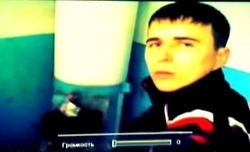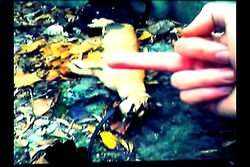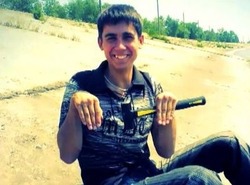Dnepropetrovsk maniacs
- miawsk2022
- Sep 25, 2022
- 8 min read
Updated: Jan 17, 2024

The Dnepropetrovsk maniacs are Ukrainian serial killers responsible for a string of murders in Dnepropetrovsk in June and July 2007. The case gained additional notoriety because the killers made video recordings of some of the murders, with one of the videos leaking to the Internet. Two 19‑year-old locals, Viktor Sayenko, born 1 March 1988, and Igor Suprunyuk, born 20 April 1988, were arrested and charged with 21 murders. A third conspirator, Alexander Hanzha, born February 1988, was charged with two armed robberies that took place before the murder spree. On 11 February 2009, all three defendants were found guilty. Sayenko and Suprunyuk were sentenced to life imprisonment, while Hanzha received nine years in prison. The lawyers for Sayenko and Suprunyuk launched an appeal, which was dismissed by the Suprime Court of Ukraine in November 2009.
The first two murders took place late at night on June 25, 2007. The first victim was a 33-year-old local woman named Ekaterina Ilchenko, who was walking home after having tea at her female friend's apartment. According to Sayenko's confession, he and Suprunyuck were "out for a walk". Suprunyuck had a hammer. As Ilchenko walked past, Suprunyuck "spun around" and struck her in the side of the head. Ilchenko's body was found by her mother at 5 AM.
Within an hour of the first murder, the two men attacked their next victim, Roman Tatarevich. He was sleeping on a bench a short walk away from the first murder scene. Tatarevich's head was smashed with blunt objects numerous times, rendering him unrecognizable. The bench he was discovered on was located across the street from the local Public Prosecutor's office.
On July 1, two more victims, Evgeniya Grischenko and Nikolai Serchuk, were found murdered in the nearby town of Novomoskovsk.
On the night of July 6, three more people were murdered in Dnepropetrovsk. The first was Egor Nechvoloda, a recently discharged army recruit, who was bludgeoned while walking home from a night club. His mother found the body in the morning by their apartment building on Bohdan Khmelnytsky Street. Elena Shram, a 28-year-old night guard, was then murdered around the corner on Kosiora Street.
According to Sayenko's taped confession, as Shram walked towards them, Suprunyuck struck her with the hammer he had been hiding under his shirt and struck her several more times after she fell down. She had been carrying a bag filled with clothes. The men picked up the bag, used the clothes to clean the hammer, and threw the bag out. Later the same night, the men murdered a woman named Valentina Hanzha (no apparent relation to co-defendant Alexander Hanzha), a mother of three married to a disabled husband.
The next day, July 7, two 14-year-old boys from Podgorodnoye, a nearby village, were attacked in broad daylight as they went fishing. One of the two friends, Andrei Sidyuck, was killed, but the other, Vadim Lyakhov, managed to escape.
On July 12, a 48-year-old man named Sergei Yatzenko, disabled by a recent bout with cancer, went missing while riding his Dnepr motorcycle. His body was found four days later, with signs of a savage attack clearly visible even after four days in the summer heat.
Thirteen more murders followed, often with multiple bodies found in the same day. In addition to the earlier sprees, two victims were found every day from July 14 through 16. Victims were seemingly selected at random. Many were vulnerable to attack, including women, children, elderly, vagrants, or people under the influence of alcohol.
Most of the victims were killed using blunt objects, including hammers and steel construction bars. Blows were often directed at the victims' faces, leaving them unrecognizable. Many victims were also mutilated and tortured, and some had their eyes gouged out while they were still alive. One of the victims was a pregnant woman, whose fetus was cut out of her womb. No sexual assaults on any victims were reported.
Some of the victims were also robbed of their cell phones and other valuables, with their possessions pawned to a large network of second-hand shops in the area. However, most victims had their possessions intact.
The murders spanned a large geographical area. In addition to the city of Dnepropetrovsk itself, many took place in the outlying areas of the Dnepropetrovsk Oblast.

Regional security chief Ivan Stupak rejected the claim that the murders had been committed to make Internet snuff videos, saying that no evidence had come to light during the investigation that supported the claim. Detective Bogdan Vlasenko stated: "We think they were doing it as a hobby, to have a collection of memories when they get old." Deputy interior minister Nikolay Kupyanskiy commented "For these young men, murder was like entertainment or hunting."
At the trial, it emerged that Suprunyuck had collected newspaper cuttings about the case. Some of the photographs of the crimes had captions added, including "The weak must die. The strongest will conquer."

Igor Suprunyuck posing with victim, 48‑year-old Sergei Yatzenko. Video will be attached in the bottom of this Blog. WARNING: The video contains graphic content. Viewer discretion advised.
Their victims had all been beaten with a hammer…but the seeds for this brutal killing spree had been planted years earlier.
The two teens had met in high school, where they bonded over a common fear of heights. They fought this fear together by dangling from skyscrapers for several hours at a time. At school, they met another teenager, whom they would ask to join their spree. His name was Alexander Hanzha, and he had a fear of blood. The duo suggested he could get over his fear by facing it head on, so they nailed a cat to a wooden cross and killed it with a gun.
They continued to kill small animals, which is a common practice among budding serial killers. They also documented these killings on video. In these tapes, the boys started to show leanings of Nazi propaganda, frequently drawing swastikas and performing Nazi salutes. After high school, the trio all found day jobs and continued to hang out. Igor took a job as a taxi driver, and the teens warmed up to their eventual crimes by robbing people who would get rides in his cab.
They committed their first murder in June of 2007, when Sayenko and Suprunyuk attacked a woman named Yekaterina Ilchenko with a hammer. Her mother would later discover her body.
That same day, Sayenko and Suprunyuk struck again. This time, they killed a man who was sleeping on a public park bench.The following week, the pair killed two more victims. By July 6, they had claimed another three lives…
On July 7, they attacked two male 14-year-old victims who were fishing. Andrei Sidyuk was killed, though the other boy, Vadim Lyakhov, was able to get away.
The surviving boy, Vadim, went right to police, who first was suspected of killing his friend. Eventually, they realized he was innocent, and he was able to supply them with composite sketches of his attackers. While police investigated the murders, Sayenko and Suprunyuk continued their spree.
Their next victim was 48-year-old Sergei Yatzenko, a cancer survivor.
They claimed even more victims in the following days and weeks, including a woman whom they killed after knocking her off her moped. It was then that two children hiding nearby spotted Sayenko and Suprunyuk fleeing the scene on her vehicle.
All three boys confessed to their crimes. In all, they killed 21 victims. During their trial, some 300 photos and two videos they had taken of their crimes were used as evidence.
Many people speculate that they filmed and took photos of their crimes to spread them online and achieve notoriety. However, police think they carried their crimes out for fun. Suprunyuk and Sayenko were given life sentences, while Hanzha was given only nine years.
It’s so sad that they carried out such awful crimes! Thank goodness they were caught and the families of the victims can find some peace.
Victims were seemingly selected at random. Many were vulnerable to attack, including children, elderly, vagrants, or people under the influence of alcohol. Most victims were killed using blunt objects, including hammers and steel construction bars. Blows were often directed at their faces, leaving them unrecognizable. Many victims were also mutilated and tortured; some victims had their eyes gouged out while they were still alive. One pregnant woman had her fetus cut from her womb.No sexual assaults on any victim were reported. Some victims were also robbed of their cell phones and other valuables, their possessions pawned to second-hand shops in the area.
The three suspects attended school together, and by age 14 found some common ground. "Me and Igor were both afraid of heights, and we were afraid we'd be beaten up by bullies", Sayenko stated during questioning. Suprunyuk sought advice on getting rid of their fears, which led the boys to stand on a balcony of their 14th floor apartment for hours, hanging over the railing. This reportedly had a positive effect on their fear of heights. Hanzha was reportedly the most squeamish of the three. He had blood phobia, and even refused to bathe his kitten, afraid he might scald it. Suprunyuk suggested tackling the fears by torturing stray dogs. The boys captured dogs in a wooded area near their house, hanged them from trees, disemboweled them, and took pictures next to the corpses.
The boys were also present at many of the funerals of the victims, sometimes taking pictures in front of the coffins or tombs showing the middle finger.

Meanwhile, authorities invaded Hanzha's home and arrested him, but not before he managed to erase the information on numerous stolen mobile phones he attempted to flush down the toilet. Sayenko, Suprunyuk, and Hanzha were all charged for numerous instances of premeditated murder (excluding Hanzha), animal cruelty, robbery, and armed robbery. All three immediately made confessions, though Suprunyuk would go on to withdraw his. Eventually, all three men were found guilty to all of their respective charges. Sayenko and Suprunyuk were both sentenced to life imprisonment, while Hanzha was sentenced to nine years in prison, the brief sentence being because Hanzha never participated in the murders. Sayenko and Suprunyuk's ghastly videos of their murders received a large amount of attention. One of the videos managed to find its way into the Internet on December 4, 2008; it is a recording of the brutal murder of Sergei Yatzenko, who was killed on July 12, 2007. The leaking of the video received criticism, but it was later admitted that control over videos posted on the Internet was "virtually impossible".

Alexander Hanzha- Was a third boy involved in the attacks. Friends of the two suspects, he never participated in any of the actual killings, but helped the boys rob the victims before they were murdered and then pawning off their valuables. In April 2019, it was reported that Alexander Hanzha had been released from prison after serving nine years and is married with two children.
On 11 February 2009, the court in Dnipro found Sayenko and Suprunyuk guilty of premeditated murder and sentenced both to life-imprisonment. Suprunyuk was found guilty of 21 murders, Sayenko of 18. They also received fifteen-year sentences after being found guilty on the robbery-charges. Hanzha, who was not involved in the killings, was found guilty of robbery and sentenced to nine years in prison. Sayenko and Suprunyuk were also found guilty on the animal cruelty charges. Hanzha said of Sayenko and Suprunyuk: "If I had known the atrocities that they were capable of committing, I would have not gone near them at gunpoint." The judge stated in the verdict that the main motive for the crimes had been a desire for "morbid self-affirmation". Referring to the accused, the court noted "the poverty of their emotional world, and their absence of interest in people and moral standards". The parents of Sayenko and Suprunyuk repeated their belief in the innocence of their sons. Vladimir Suprunyuk claimed that Igor had been tortured to extract his confession, with the police covering his head and forcing him to inhale cigarette smoke. Speaking at a televised press conference, he cited irregularities in the investigation and said that the case against his son was false. In April 2011, a poll found that nearly 60% of Ukrainians wanted the death-penalty available for serial-killings where judicial error had been ruled out.


































Comments